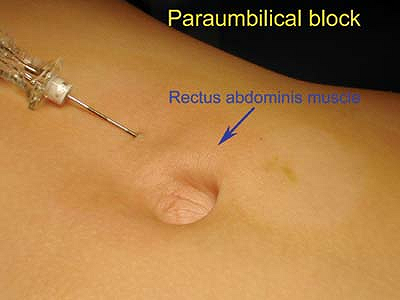Paraumbilical Block
Editors: Chelly, Jacques E.
Title: Peripheral Nerve Blocks: A Color Atlas, 3rd Edition
Copyright ©2009 Lippincott Williams & Wilkins
> Table of Contents > Section V – Pediatric Peripheral Blocks > 53 – Paraumbilical Block
53
Paraumbilical Block
Giorgio Ivani
Valeria Mossetti
The external layer of the rectus sheath on both sides of the abdomen is
marked. A short beveled needle is then introduced at the crossing of
the outer border of this muscle with the horizontal line passing over
the umbilicus. The needle is introduced and advanced at a 60° angle to
the skin in the direction of the umbilicus until there is a loss
resistance, corresponding to the piercing of the rectus sheath. This
piercing is clearly identified by a “pop” because the sheath is rather
resistant. After the injection of the volume of local anesthetic the
same technique is repeated on the other side.
-
The paraumbilical area is innervated by
branches of the 10th intercostal nerves after they have penetrated the
rectus sheath, which covers the rectus abdominis muscle. -
This technique is quite simple, virtually free of complications and its success rate is very high.
 |
|
Figure 53-1. Umbilicus, rectus abdominis muscles.
|
P.362
Suggested Readings
Courrèges P, Poddevin F, Lecoutre D. Para-umbilical block: a new concept for regional anaesthesia in children. Paediatr Anaesth 1997;7:211.
Ferguson S, Thomas V, Lewis I. The rectus sheath block in paediatric anaesthesia: new indications for an old technique? Paediatr Anaesth 1996;6:463.
Willschke
H, Bosenberg A, Marhofer P, et al. Ultrasonography-guided rectus sheath
block in paediatric anaesthesia—a new approach to an old technique. Br J Anaesth 2006;97(2):244–249.
H, Bosenberg A, Marhofer P, et al. Ultrasonography-guided rectus sheath
block in paediatric anaesthesia—a new approach to an old technique. Br J Anaesth 2006;97(2):244–249.
